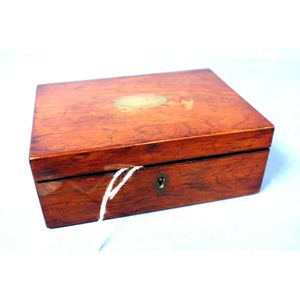Victorian Sterling Silver Cutlery Set with Oak Canteen
A Victorian sterling silver, Old English bright cut pattern, cutlery set with oak canteen case 1868 London, by George Adams 105pcs in total top tray canteen comprising of: 18 table forks, matching hallmarks 18 dessert forks, matching hallmarks 10 dessert spoons, 9 matching marks, 1 later 1883 4 mustard spoons, matching hallmarks lower canteen comprising of: 12 table spoons, matching hallmarks 12 tea spoons, matching marks 4 serving ladles, matching marks 2 basting spoons, matching marks 1 soup ladle, earlier mark 1842 total approx. Silver weight 4899gms 12 sterling handle table knives, stainless blades 12 sterling handle dessert knives, stainless blades mid 20th century, Sheffield hallmarks. Height 14 cm. Width 50 cm. Depth 31 cm (canteen)
You must be a subscriber, and be logged in to view price and dealer details.
Subscribe Now to view actual auction price for this item
When you subscribe, you have the option of setting the currency in which to display prices to $Au, $US, $NZ or Stg.
This item has been sold, and the description, image and price are for reference purposes only.
- Sterling Silver - Sterling silver is a mixture of 92.5% pure silver and 7.5% of another metal, usually copper. Fine silver is 99.9% pure silver, and is relatively soft and the addition of the very small amount of copper gives the metal enough strength and hardness to be worked into jewellery, decorative and household objects.
- Canteen - A small cabinet, table or a box with drawers or lift out trays, for storing a set of cutlery.
- Victorian Period - The Victorian period of furniture and decorative arts design covers the reign of Queen Victoria from 1837 to 1901. There was not one dominant style of furniture in the Victorian period. Designers used and modified many historical styles such as Gothic, Tudor, Elizabethan, English Rococo, Neoclassical and others, although use of some styles, such as English Rococo and Gothic tended to dominate the furniture manufacture of the period.
The Victorian period was preceded by the Regency and William IV periods, and followed by the Edwardian period, named for Edward VII (1841 ? 1910) who was King of the United Kingdom and the British Dominions and Emperor of India for the brief period from 1901 until his death in 1910. - Hallmarks - A mark stamped on articles of precious metals in Britain, since the 14th century, certifying their purity. It derives its name from the Guild Hall of the Goldsmiths' Company, who recieved its Charter in 1327 giving it the power to assay (test the purity) and mark articles of gold and silver.
The hallmark will consist of several marks, including the:
- silver standard mark, indicating the purity of the metal. Sterling silver is .925 pure silver.
- the city mark indicating the city in which it was assayed eg London, Birmingham, York etc.
- the date mark, usually a letter of the alphabet in a particular font and case,
- a duty mark, indicating whether duty had been paid to the crown, and only in use from 1784 to 1890
The piece may include an additional mark, the maker's mark, although not forming part of the hallmark, will be located in the vicinity of the hallmarks.
Sometimes silver plated items will bear faux hallmarks, often confusing those not familiar with silver markings. - Oak - Native to Europe and England, oak has been used for joinery, furniture and building since the beginning of the medieval civilisation. It is a pale yellow in colour when freshly cut and darkens with age to a mid brown colour.
Oak as a furniture timber was superceded by walnut in the 17th century, and in the 18th century by mahogany,
Semi-fossilised bog oak is black in colour, and is found in peat bogs where the trees have fallen and been preserved from decay by the bog. It is used for jewellery and small carved trinkets.
Pollard oak is taken from an oak that has been regularly pollarded, that is the upper branches have been removed at the top of the trunk, result that new branches would appear, and over time the top would become ball-like. . When harvested and sawn, the timber displays a continuous surface of knotty circles. The timber was scarce and expensive and was used in more expensive pieces of furniture in the Regency and Victorian periods.
This item has been included into following indexes:
Visually similar items

Antique rosewood trinket box, with brass cartouche inscribed 'Mary bell', 14.5 cm x 10.5 cm, 5.5 cm high approx.
Sold by
in
for
You can display prices in $Au, $US, $NZ or Stg.

A cedar writing slope, with whalebone escutcheon, Australian, circa 1860, 14 cm high, 41 cm wide, 24.5 cm deep
Sold by
in
for
You can display prices in $Au, $US, $NZ or Stg.

Antique mahogany military brass bound lap desk. Has key. Approx 13 cm high by 46 cm long by 32 cm deep.
Sold by
in
for
You can display prices in $Au, $US, $NZ or Stg.

Georgian rosewood tea caddy, width 17.5 cm, diameter 10 cm approx
Sold by
in
for
You can display prices in $Au, $US, $NZ or Stg.
